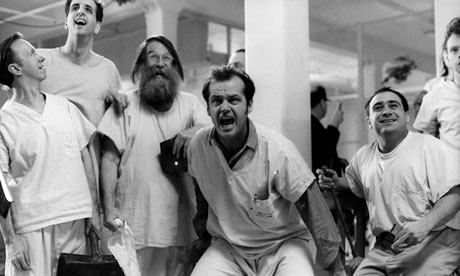Let me begin by getting this out of the way: The Silver Linings Playbook is a nuanced and sympathetic portrayal of the mentally ill. At parts.
 For those who are not familiar with the film, The Silver Linings Playbook is about a man named Pat who struggles with bipolar disorder. Estranged from his wife after he had a violent episode upon discovering her with another man, he has spent eight months in treatment, and is now looking to reconcile with his wife despite his wife having moved on. On the way, he meets a woman named Tiffany, who also struggles with mental illness. They gradually grow closer together through their shared neuroses, and engage in a kind of social therapy through practicing together for an upcoming dance competition, yet Pat still struggles with his interest in Tiffany and his refusal to move on from his wife.
For those who are not familiar with the film, The Silver Linings Playbook is about a man named Pat who struggles with bipolar disorder. Estranged from his wife after he had a violent episode upon discovering her with another man, he has spent eight months in treatment, and is now looking to reconcile with his wife despite his wife having moved on. On the way, he meets a woman named Tiffany, who also struggles with mental illness. They gradually grow closer together through their shared neuroses, and engage in a kind of social therapy through practicing together for an upcoming dance competition, yet Pat still struggles with his interest in Tiffany and his refusal to move on from his wife.Had the film stayed like this, it would have been fine. The film contains stories which many of us can relate to. Stories of people who struggle with mental illness, stories of their family who struggle with their struggles. It makes headway by having a mentally ill protagonist who has been violent who is not defined by his violence and mental illness, but rather that it is one of many issues he struggles with, along a sense of abandonment, refusal to let go of the past, and a fear of further failure.
The problem is that, while it is many ways respectful of mental illness, in many ways it is also misleading, dishonest, and in some cases outright disrespectful of people with mental illness and the struggles they go through."
Here are the three big problems with Silver Linings Playbook:
Mental Illness Becomes "Cute"
Since at least the time of "One Flew Over The Cuckoo's" nest, mental illness has been shown through a distorted, saccharine perspective, portraying those who have it as quirky or creative "free spirits" rather than sufferers of the debilitating and destructive force that mental illness is.
Pat often behaves in a very childlike manner, getting easily distracted and having over-the-top reactions to circumstances. He speaks in a fast-paced and stream-of-consciousness style, and while such a speaking style is a symptom of mania among people with Bipolar disorder, the film often focuses on it for comedic effect. Even though the disorder that leads to him acting like that is the same disorder that leads to him throwing a book out the window after he disagrees with how it ends.
Pat's father's OCD manifests primarily as an interesting quirk, mostly involving him having specific and arbitrary rituals while watching the football game. In reality, OCD in its most severe forms is extremely debilitating, and often those with it feel a compulsion to perform their ritual tasks over and over again even when they know they should not, and they often feel as if they have no control over much of their own lives. And while that shows up to some degree after the Eagles lose and Pat's father becomes very distressed, for the most part that harsh reality is downplayed in favor of portraying OCD in comedic terms. Even when Pat's father's OCD results in him betting all of his money on the outcome of the dance competition/football game at the end of the film, the ramifications of his untreated OCD are glossed over and it instead becomes a problem for Pat and Tiffany to solve.
 What's odd is that these moments of "quirky" mental illness appear alongside much more nuanced and realistic portrayals of mental illness. The film that has Pat suffering a mental breakdown in the attic while his parents desperately try to soothe him is the same film where an increasingly irate and distressed Pat becomes immediately calm when he is distracted by his friend giving him an old Ipod. Pat's rapid stream-of-consciousness speaking exists alongside his unrealistic and damaging goals he sets for himself. Yet in both cases one of the situations is played for laughs while the other is viewed with concern, as though they were not both root of the same problem. The result is an inconsistent and overexagerrated portrayal of mental illness, where the viewer cannot always tell what is actually true mental illness, and what is exaggerated for filmic effect.
What's odd is that these moments of "quirky" mental illness appear alongside much more nuanced and realistic portrayals of mental illness. The film that has Pat suffering a mental breakdown in the attic while his parents desperately try to soothe him is the same film where an increasingly irate and distressed Pat becomes immediately calm when he is distracted by his friend giving him an old Ipod. Pat's rapid stream-of-consciousness speaking exists alongside his unrealistic and damaging goals he sets for himself. Yet in both cases one of the situations is played for laughs while the other is viewed with concern, as though they were not both root of the same problem. The result is an inconsistent and overexagerrated portrayal of mental illness, where the viewer cannot always tell what is actually true mental illness, and what is exaggerated for filmic effect.Most of the Mentally Ill Characters Are Violent
For a long time, films have portrayed the mentally ill as violent. We've all seen episodes of crime procedurals where the culprit is a someone "crazy", with untreated (or in some cases, treated) mental illness). While Silver Linings does take steps to not define the mentally ill characters by their violence, and humanizes them, it nonetheless portrays mental illness, for the most part, as accompanied by violent behavior.
Pat is sent to a mental health facility when he beats up the man his wife is having an affair with. Pat's father has a history of violence. Tiffany slaps, shouts, and destroys tableware over the course of the film. The one mentally ill character who is not violent is Chris Tucker's character, yet he has very little screen presence in the movie.
In reality, most people with mental illness are not violent, just as the majority of the general population is not violent. In fact, people with mental illness are far more likely to be victims of violence than perpetrators.
In fairness, violence is prevalent throughout film and television, not just in those with mental illness. It's an easy, concise, and visual way to make conflicts more interesting. It becomes much more palatable to show a divorced couple battling over alimony, for example, if you include a knife fight between their lawyers. Yet while in such a scenario that violence can be more easily accepted as Hollywood exaggeration, because we know such scenarios aren't so violent in real life, with mental illness it becomes much more problematic because many of us don't have those real life scenarios to compare it to. The end result is people see those crime procedurals, those murder mysteries, and even this film, with mentally ill characters that are violent, and they conclude that mentally ill people as a whole are just as violent.
The Ending Ignores The Mental Illness of the Characters
The most damning part of the film, however, isn't how it portrays the mentally ill and their issues, but how it sweeps those issues under the rug in favor of a typical Hollywood happy ending.
While the first two acts of the film have been about how Pat and Tiffany grow closer to each other and struggle with their mental illness, the third act of the film is about how the two have to work past their issues to score a five in the dance competition. At the end of the film, they score that five, and Pat and Tiffany become a couple, and the issue of their mental illness is not brought up to any significant extent again.
One of the possible themes for this film that I've heard is "Anyone can find love, even broken people and misfits", which is a good sentiment and all, but the film does not support that. Suppose you knew two people in real life, both mentally ill, who became a couple. Suppose they struggled with their mental illness and how their mental illness affected each other. Suppose that, instead of focusing on treatment and therapy for their illness, they instead invest their time and energy into winning a dance competition, and put any thoughts of therapy or treatment out of their head for the entirety of the time prior to this dance competition.
One of the possible themes for this film that I've heard is "Anyone can find love, even broken people and misfits", which is a good sentiment and all, but the film does not support that. Suppose you knew two people in real life, both mentally ill, who became a couple. Suppose they struggled with their mental illness and how their mental illness affected each other. Suppose that, instead of focusing on treatment and therapy for their illness, they instead invest their time and energy into winning a dance competition, and put any thoughts of therapy or treatment out of their head for the entirety of the time prior to this dance competition.
We would say they were ignoring the larger problem.
That's exactly what this film does. It ignores the larger problem of these characters and their issues. Both characters are still suffering from untreated mental illness (I say untreated because, though both characters take medication and therapy, the film downplays this and neither therapy or medication seem to have a substantial effect on their well-being), and the ending of the film implies that they will be in a closer relationship with one another. As anyone who has been in a relationship with someone with untreated mental illness knows, the effects are hard enough when there is only one person. Indeed, we've already seen this in the film with how Pat's wife had a restraining order put on him. The effects are multiplied when both people are mentally ill. These are two individuals who do not know how to cope with and control their mental illness, and both have a tendency for exaggerated, violent outbursts. If their story continues as it had, their relationship will end, and none of the possible endings will be happy.
It could be argued that the film isn't about providing a true portrayal of mental illness, that it is about other things. Yet if that is the case, why include mental illness? Is it meant simply as an interesting backdrop to a different story? Does mental illness deserve to be used as the backdrop to a story, especially when the film does not show a full understanding of mental illness?
Or does it turn mental illness into a caricature? Does it narrow the perspective on these people and view them solely in relation to other, more "important" issues? If a film uses something only to do a disservice to what that something actually is, it shouldn't be using it.





No comments:
Post a Comment